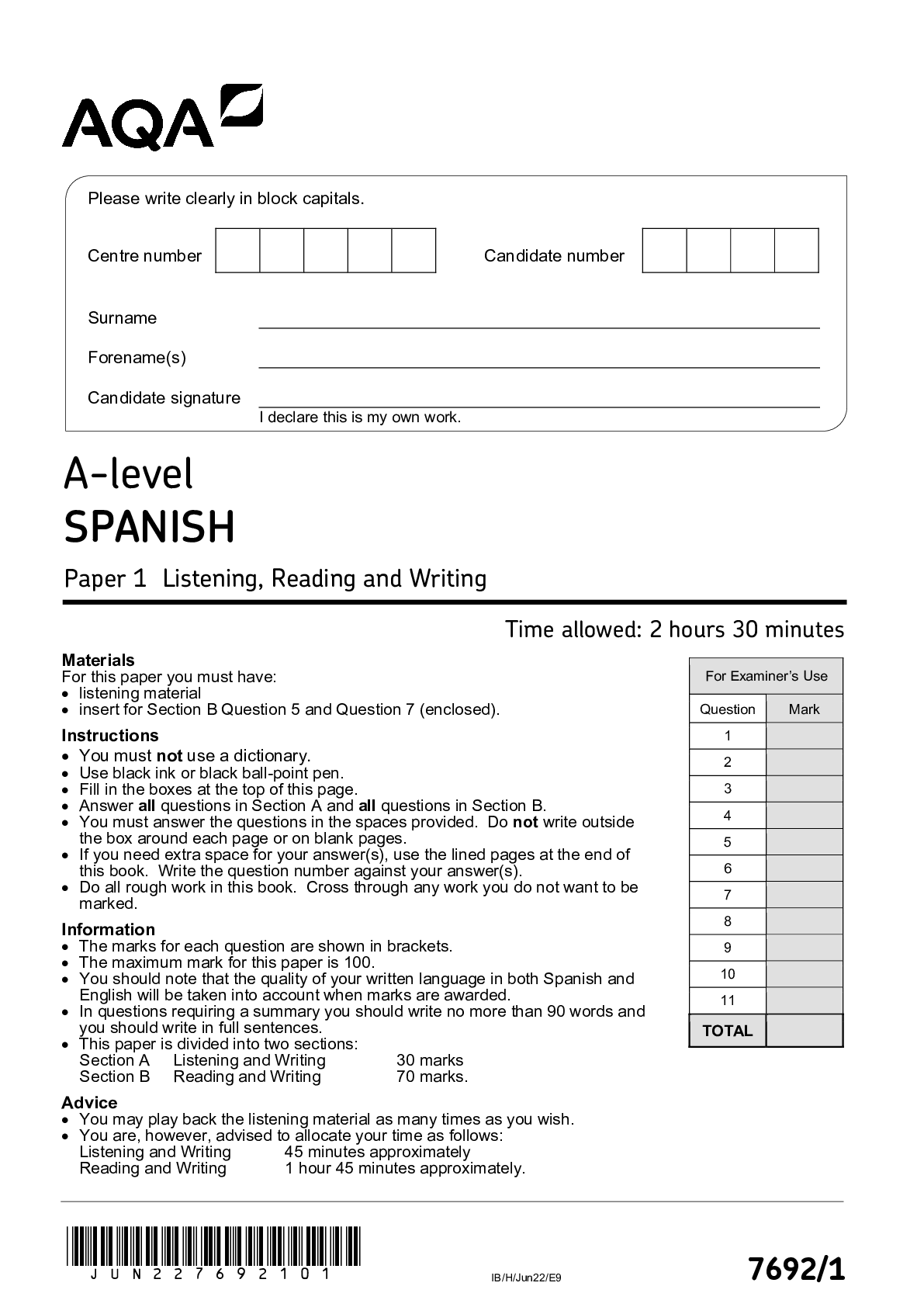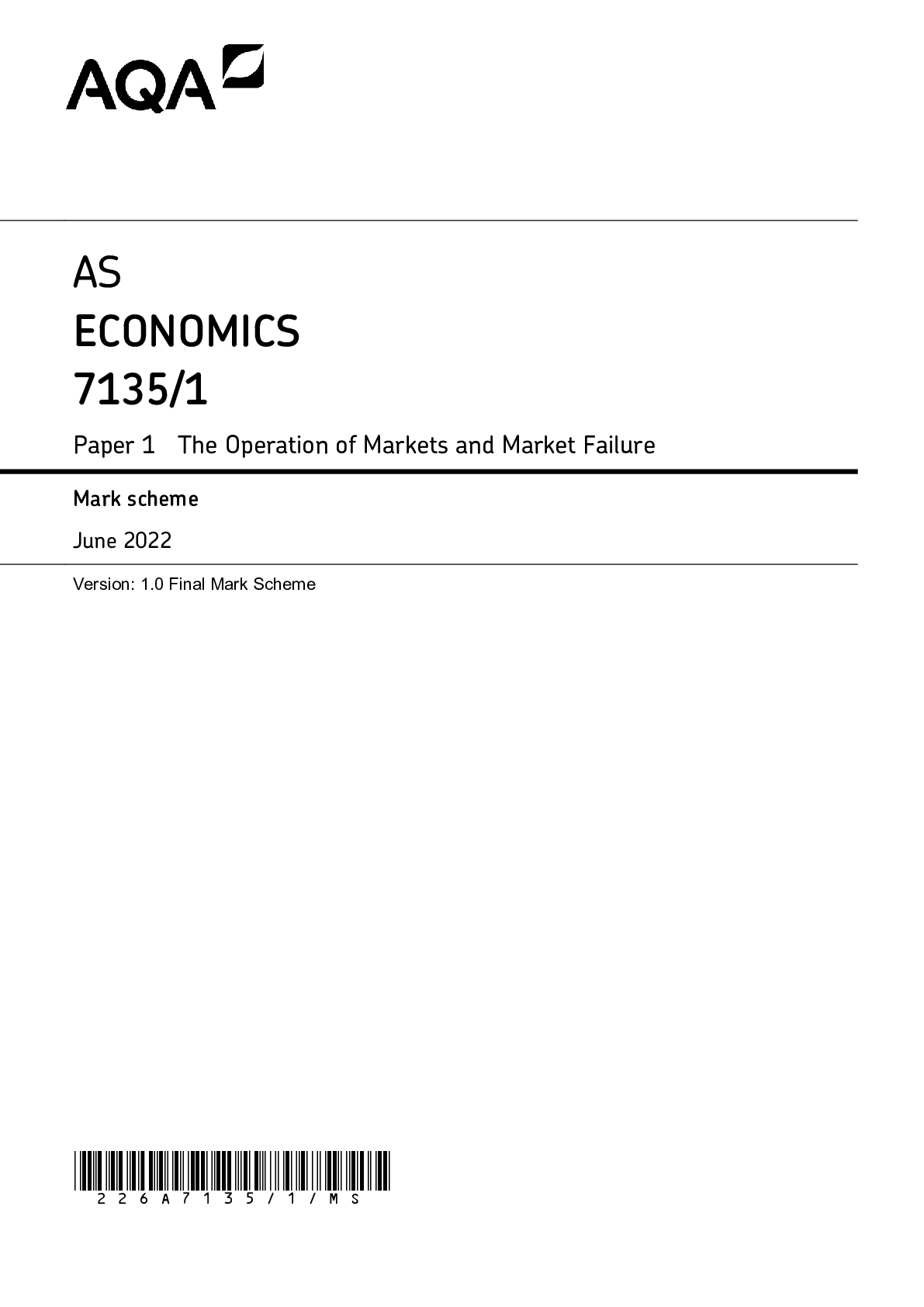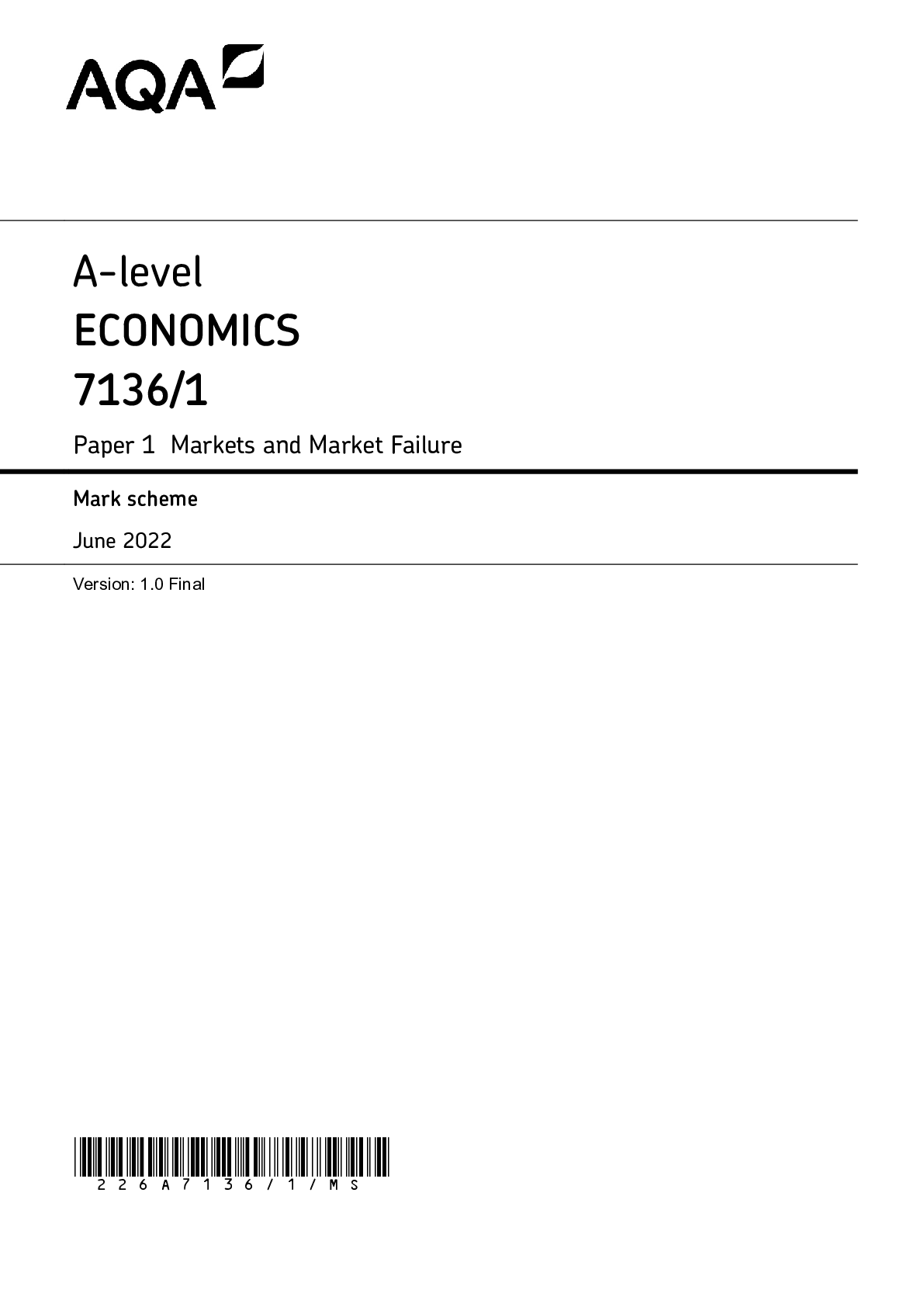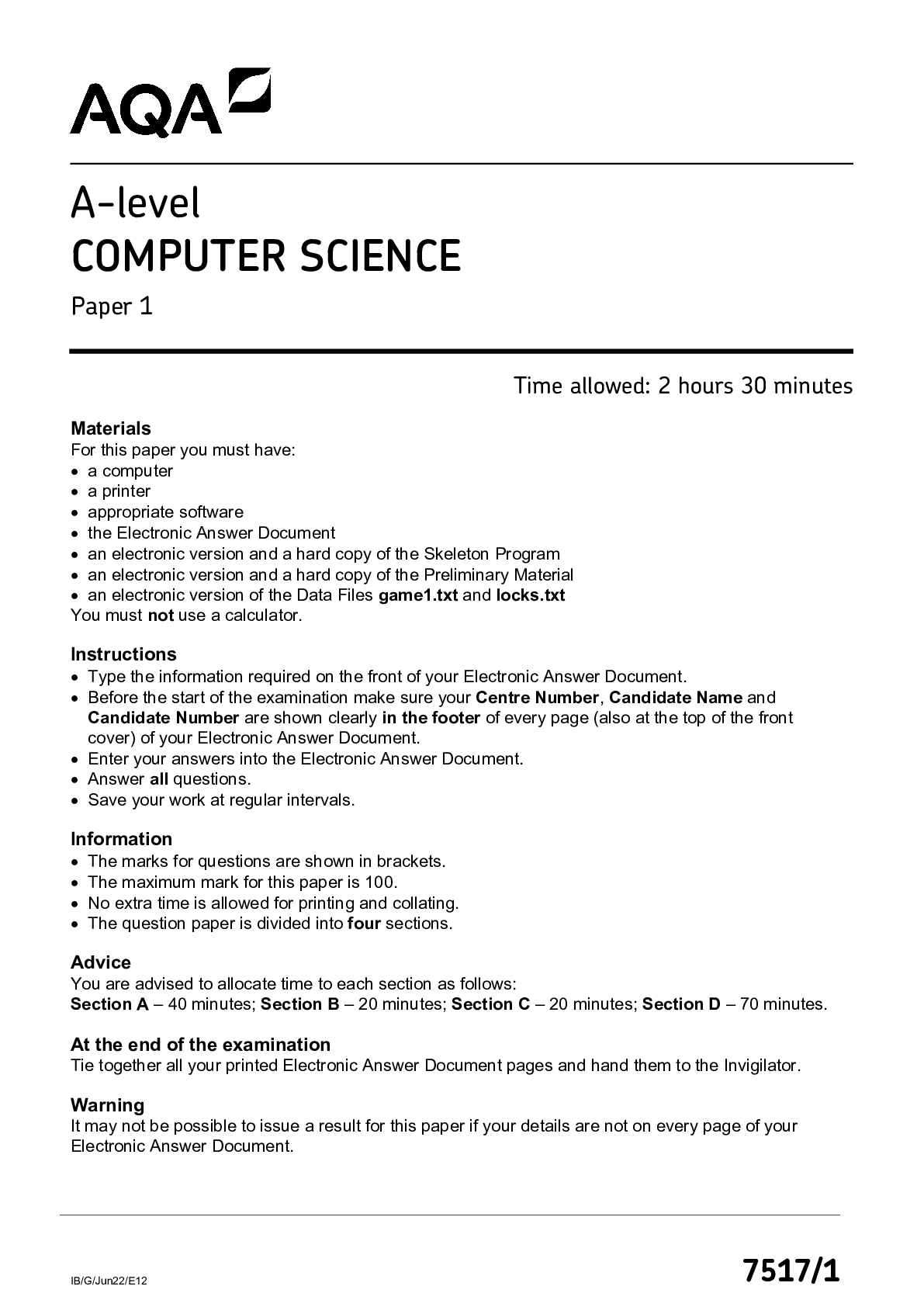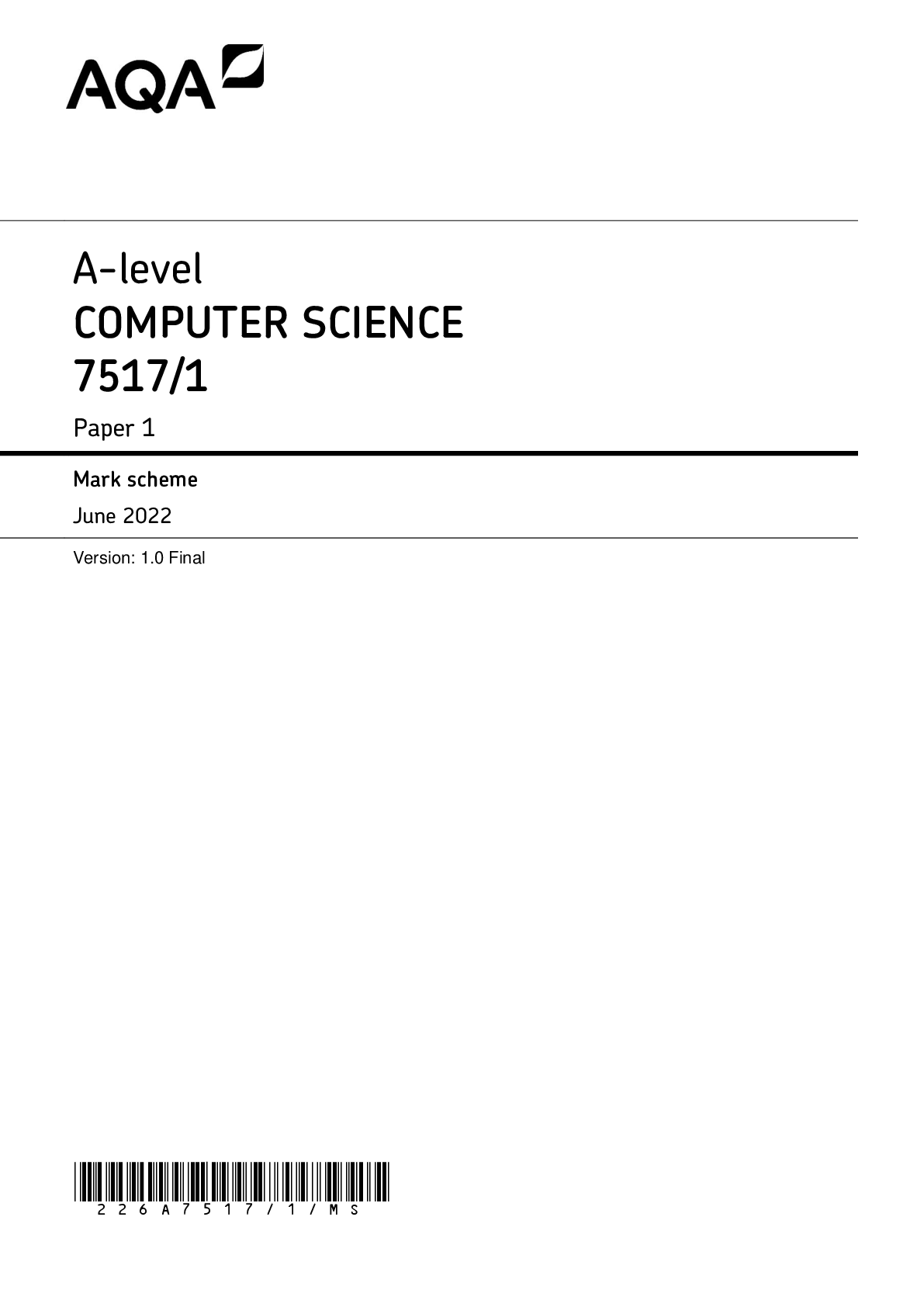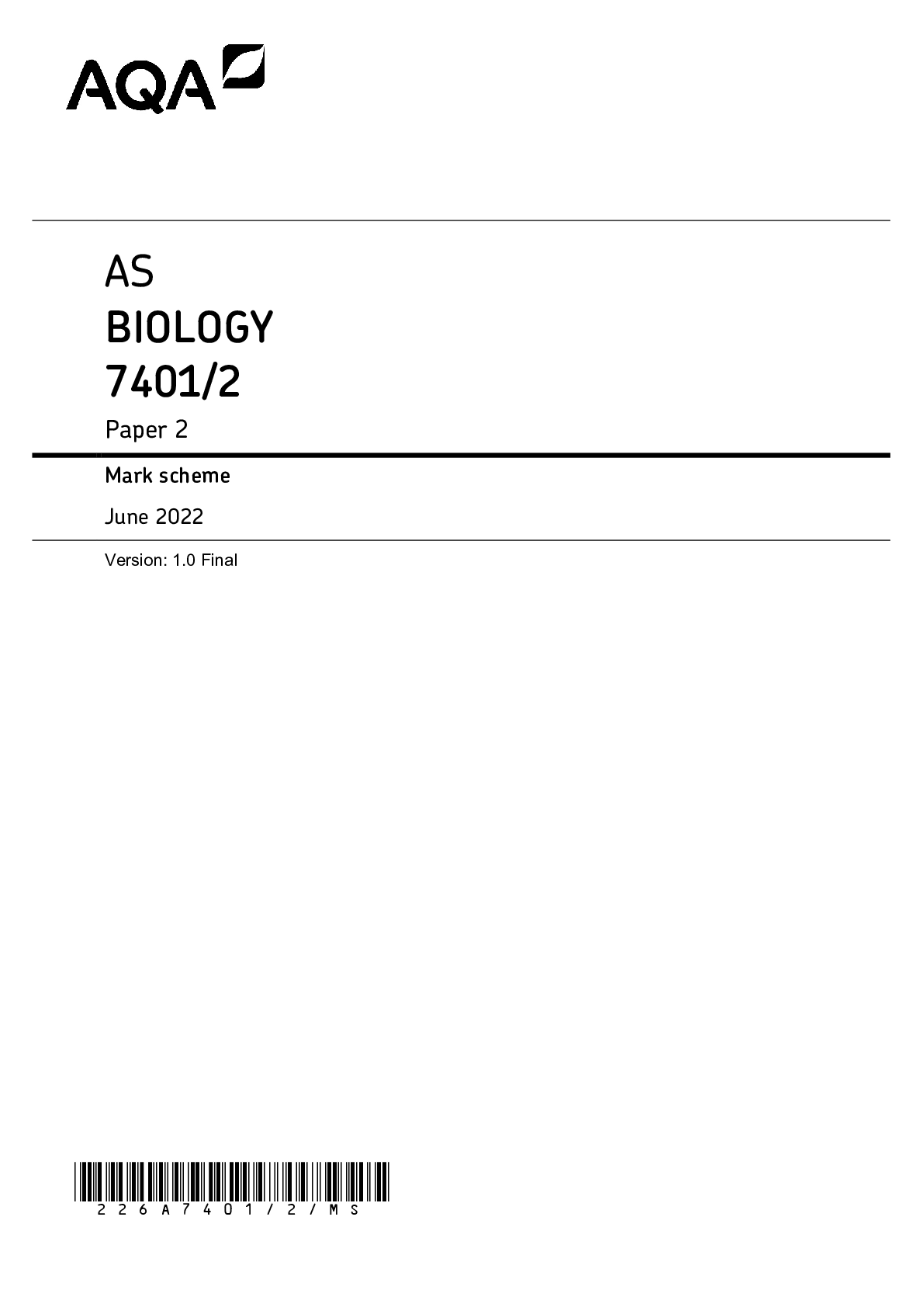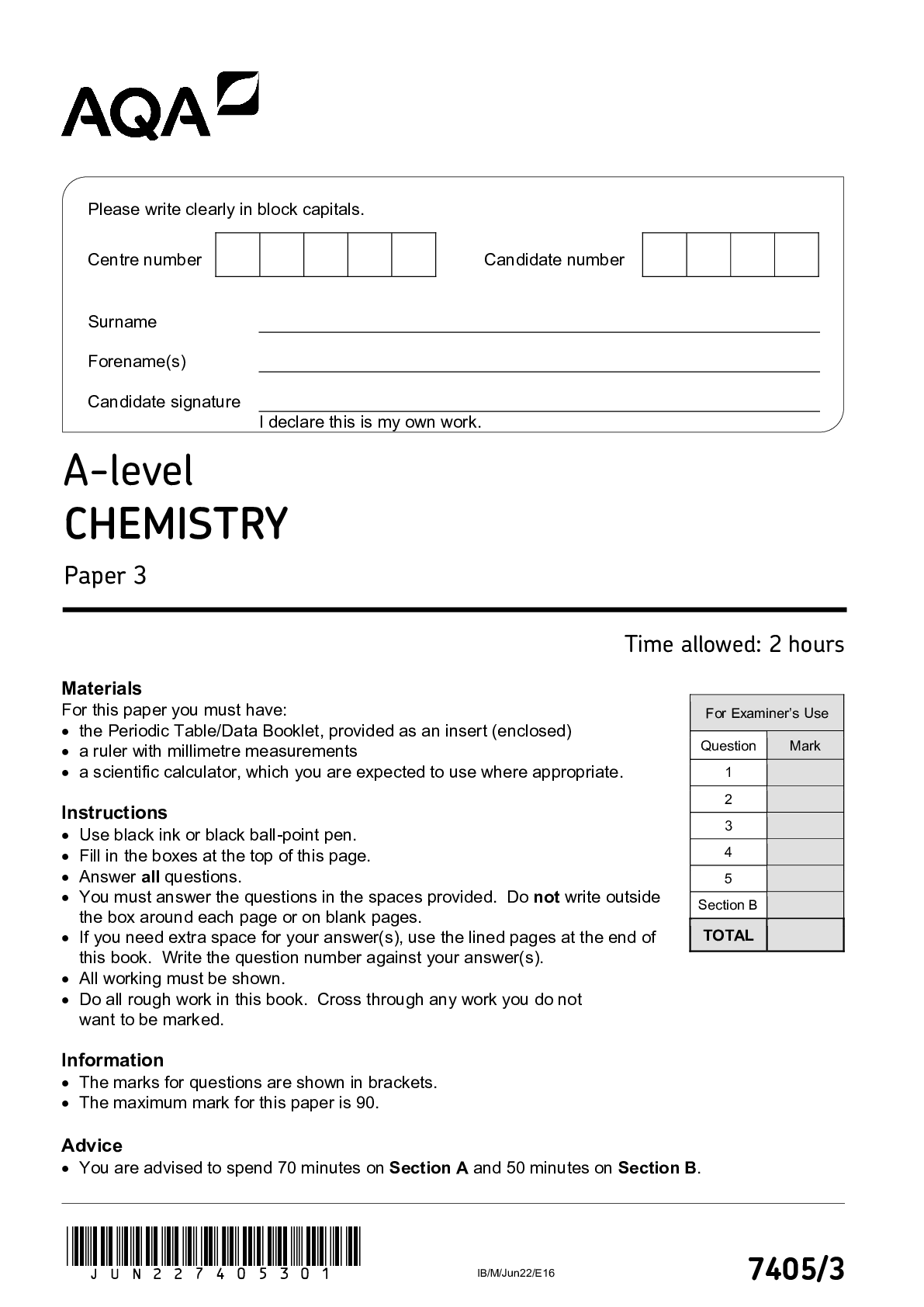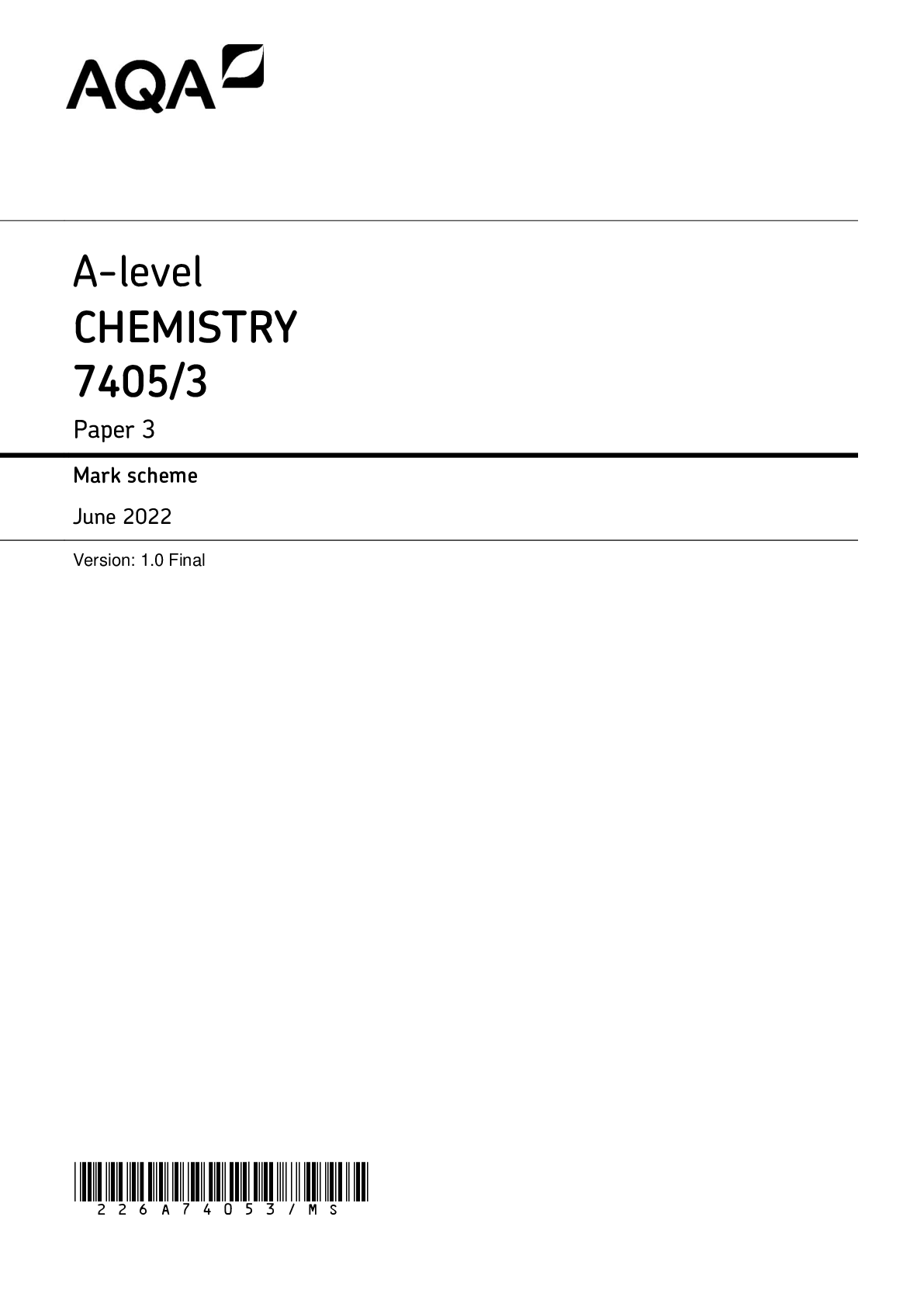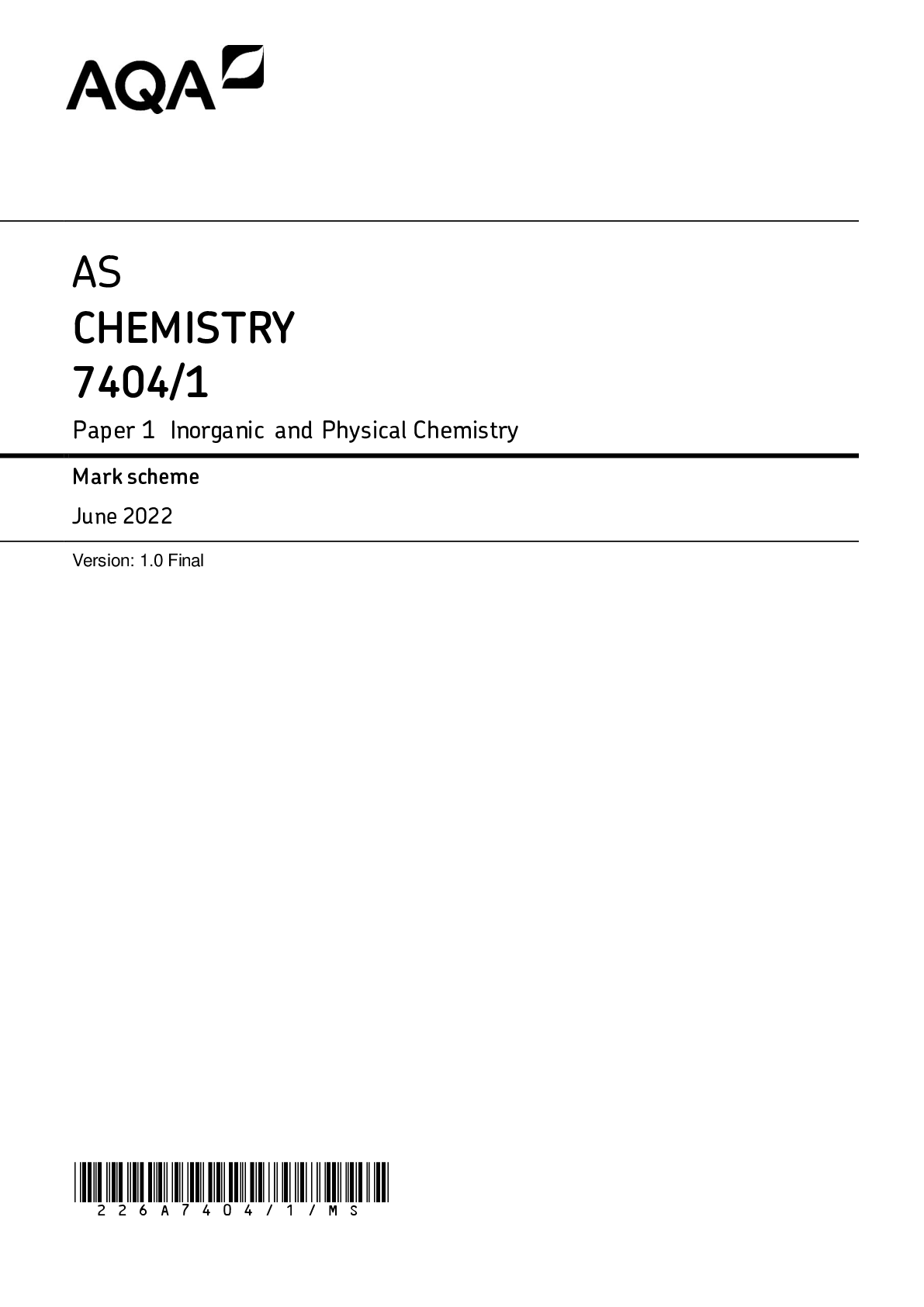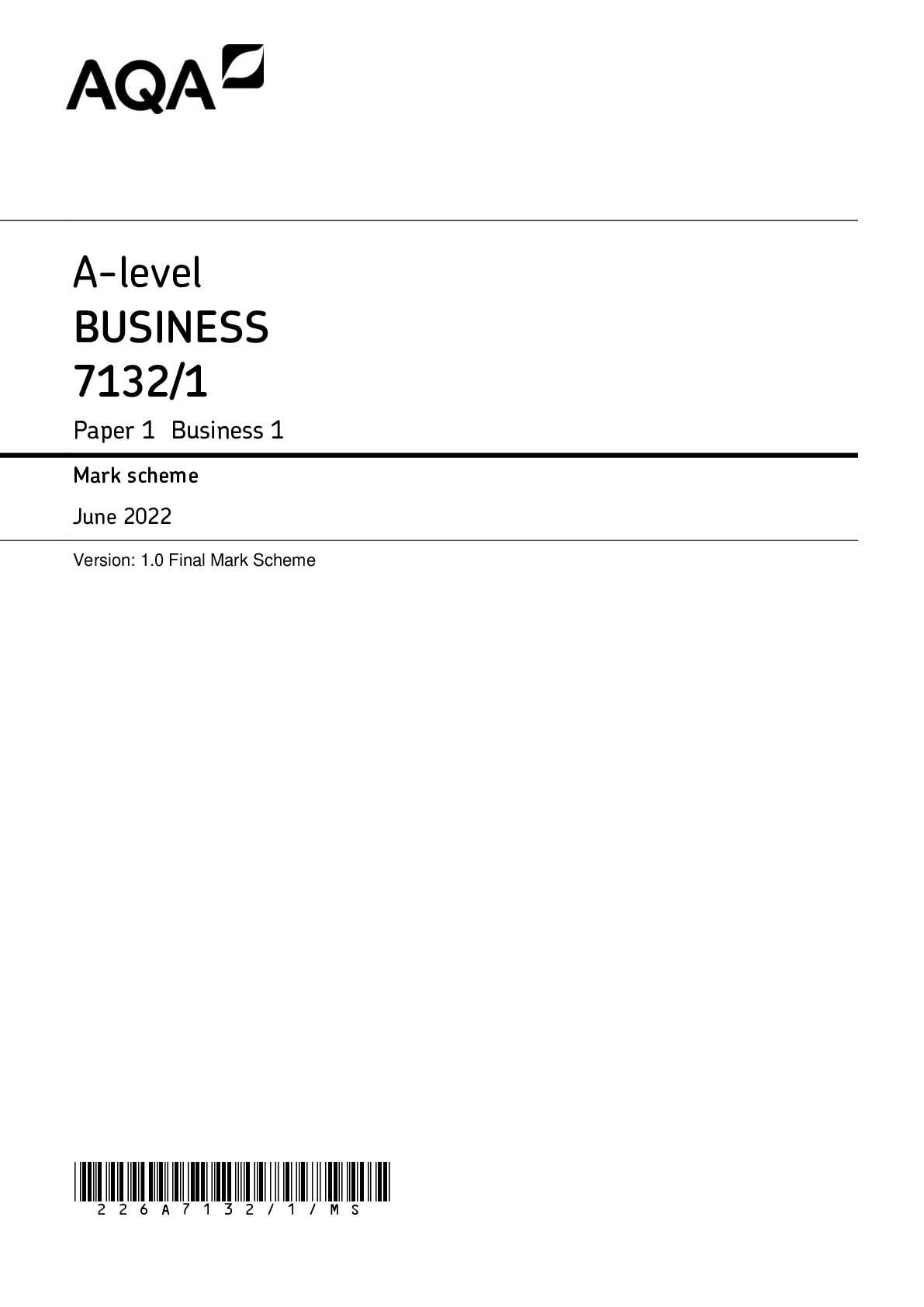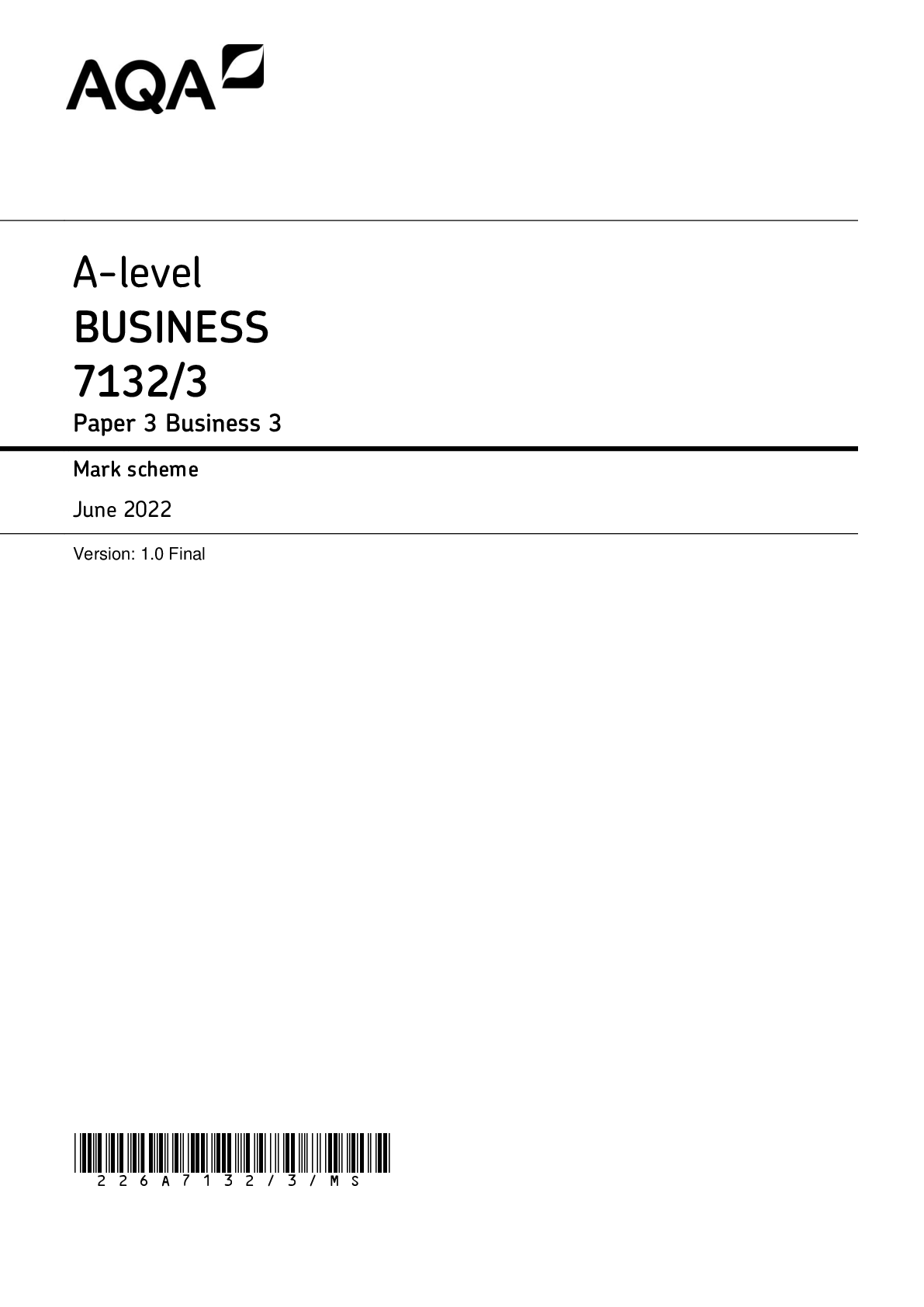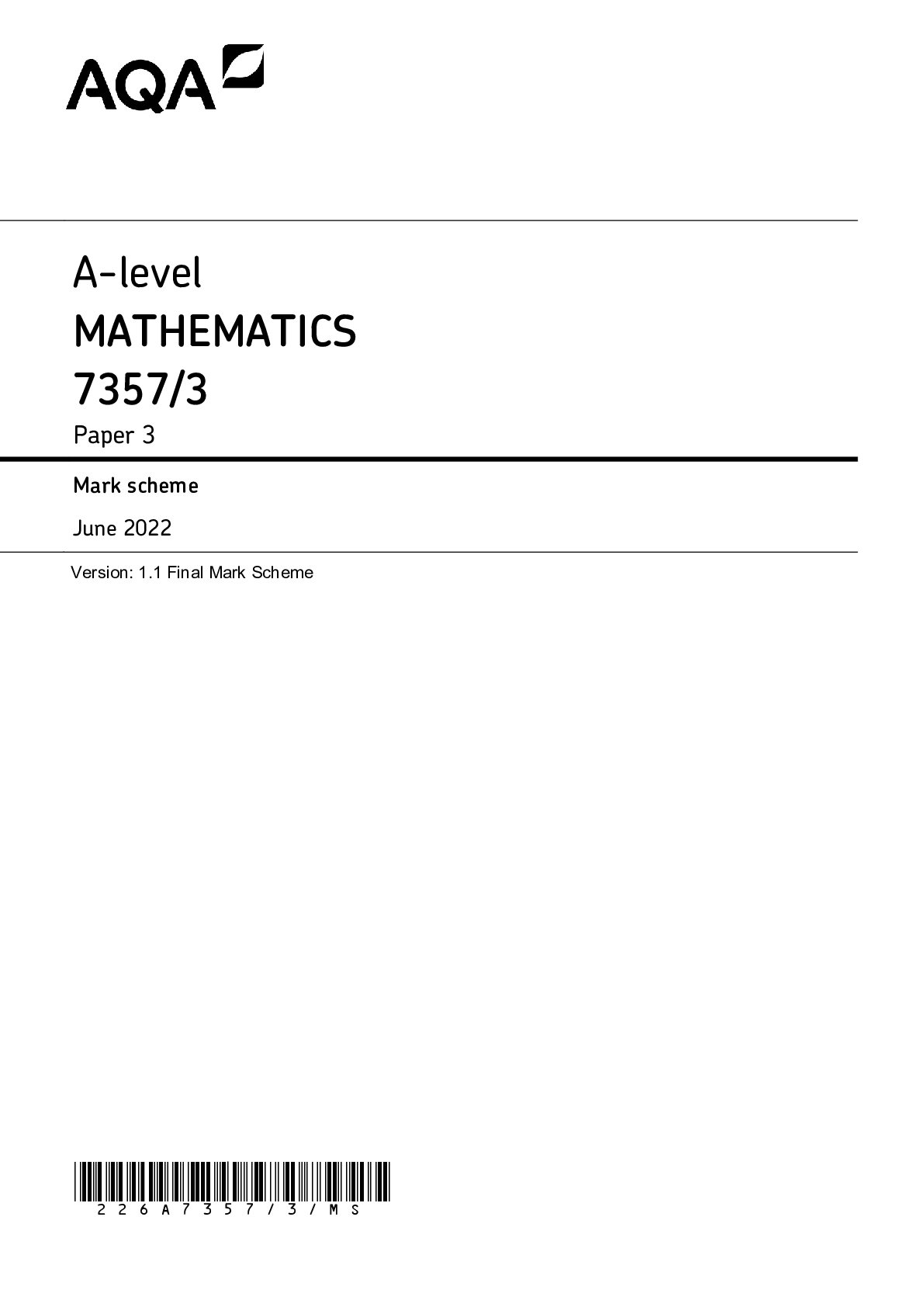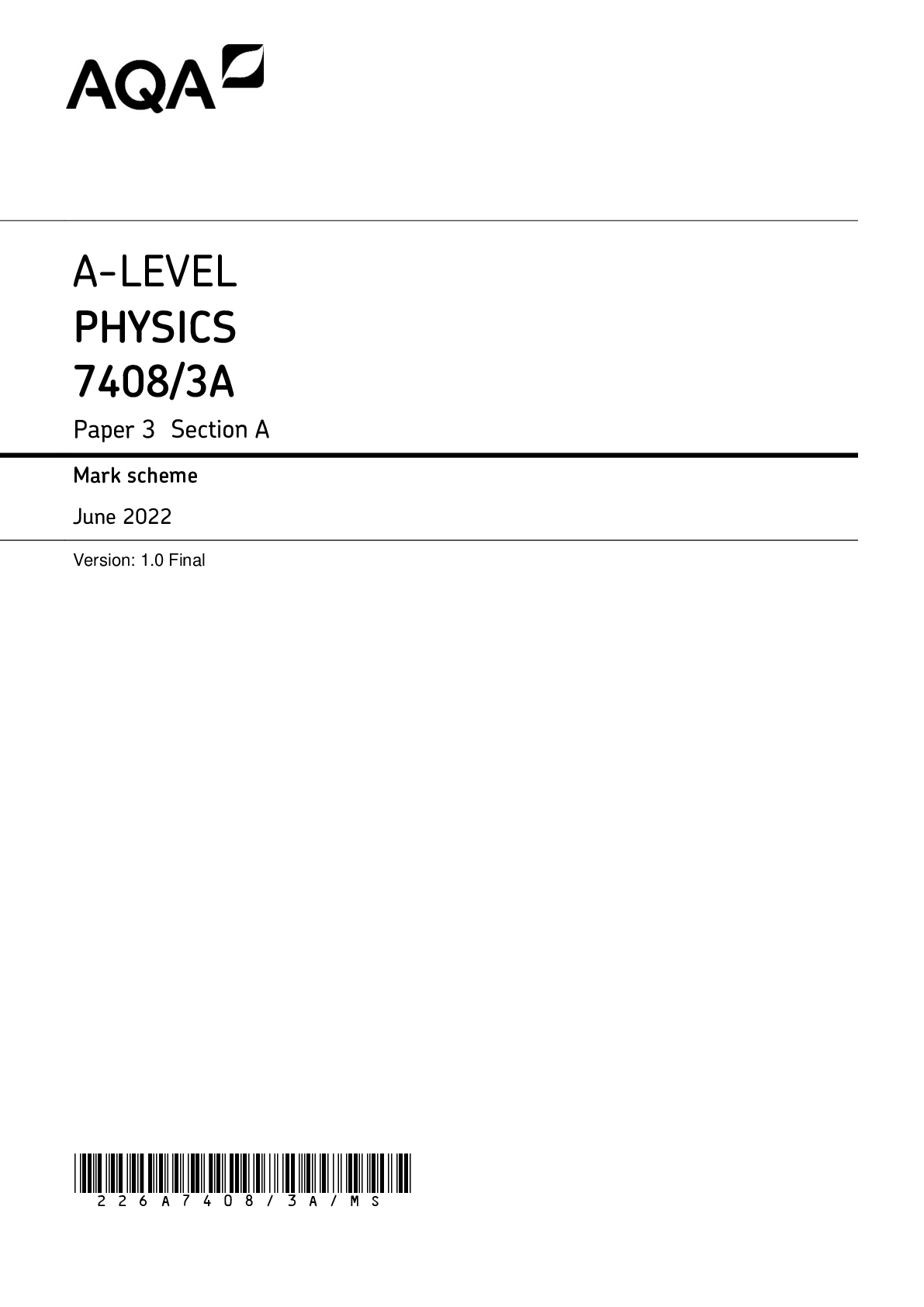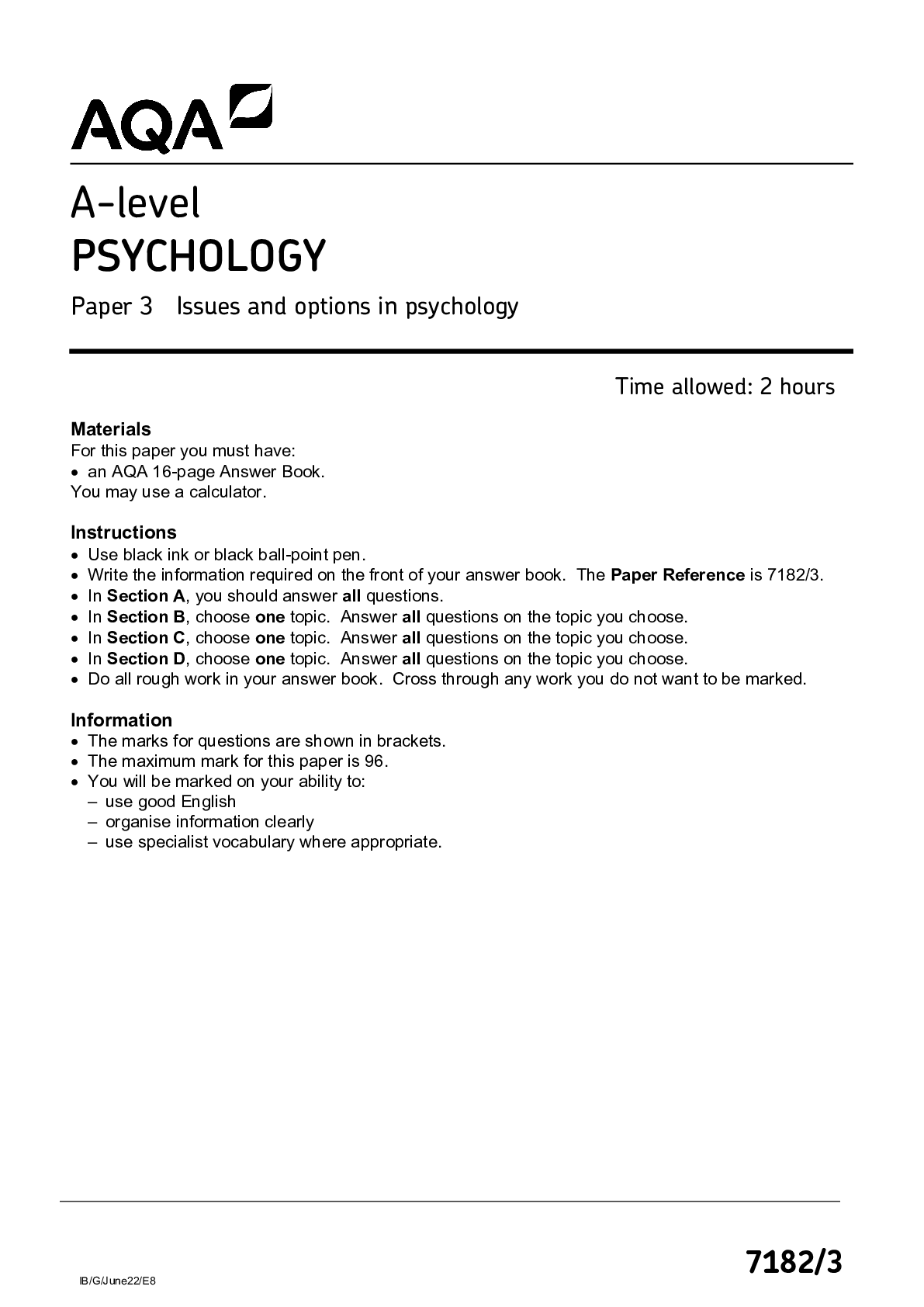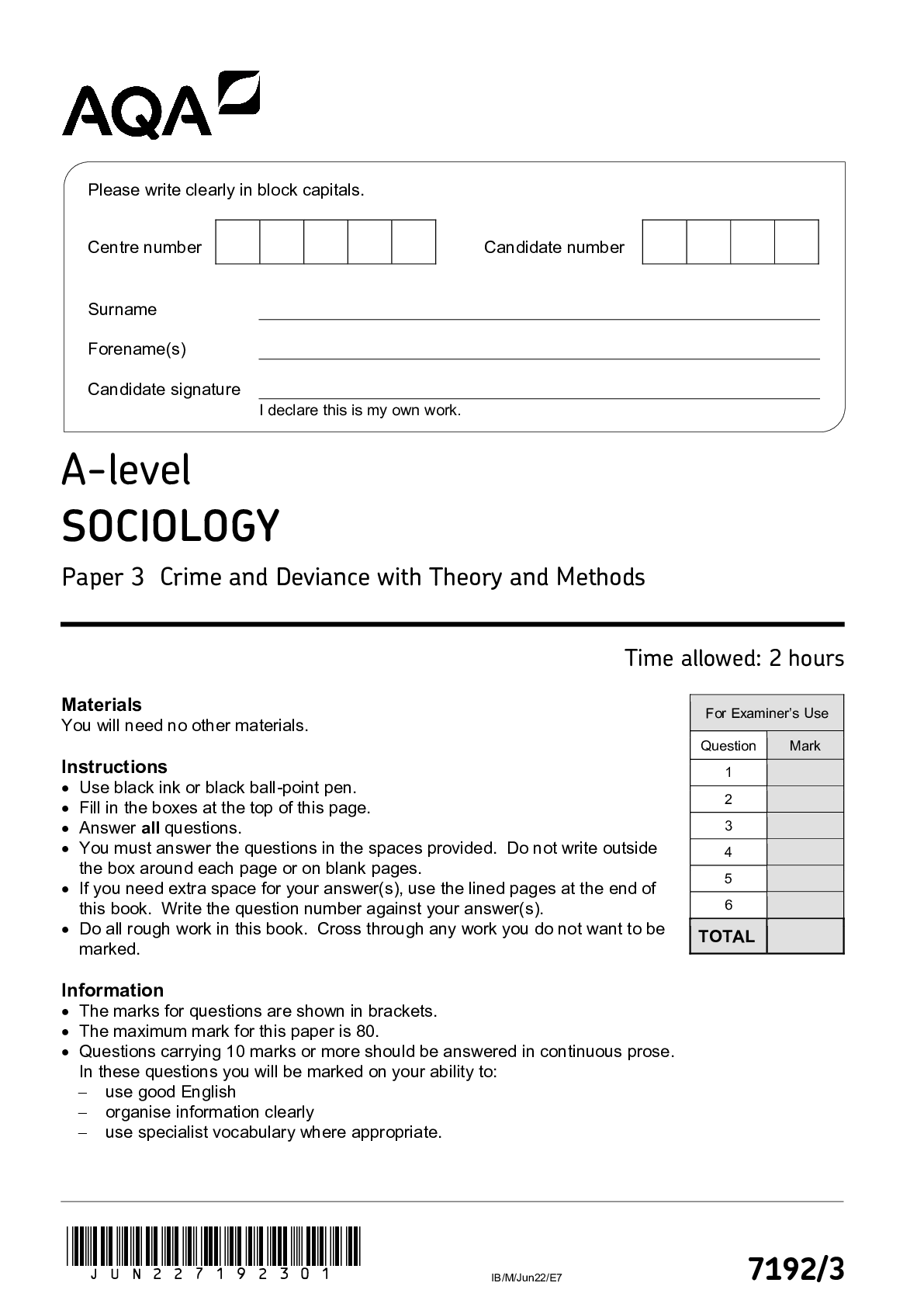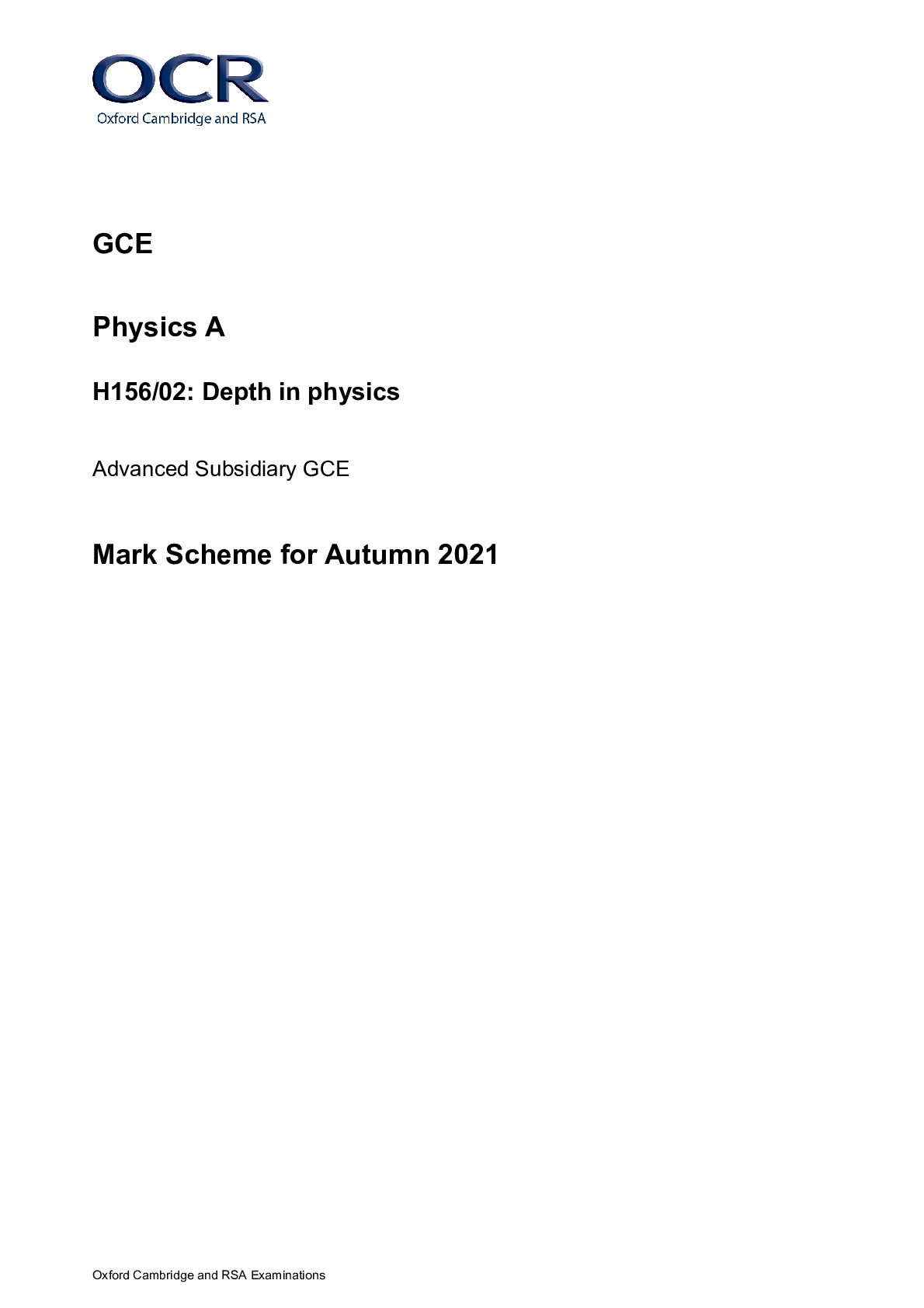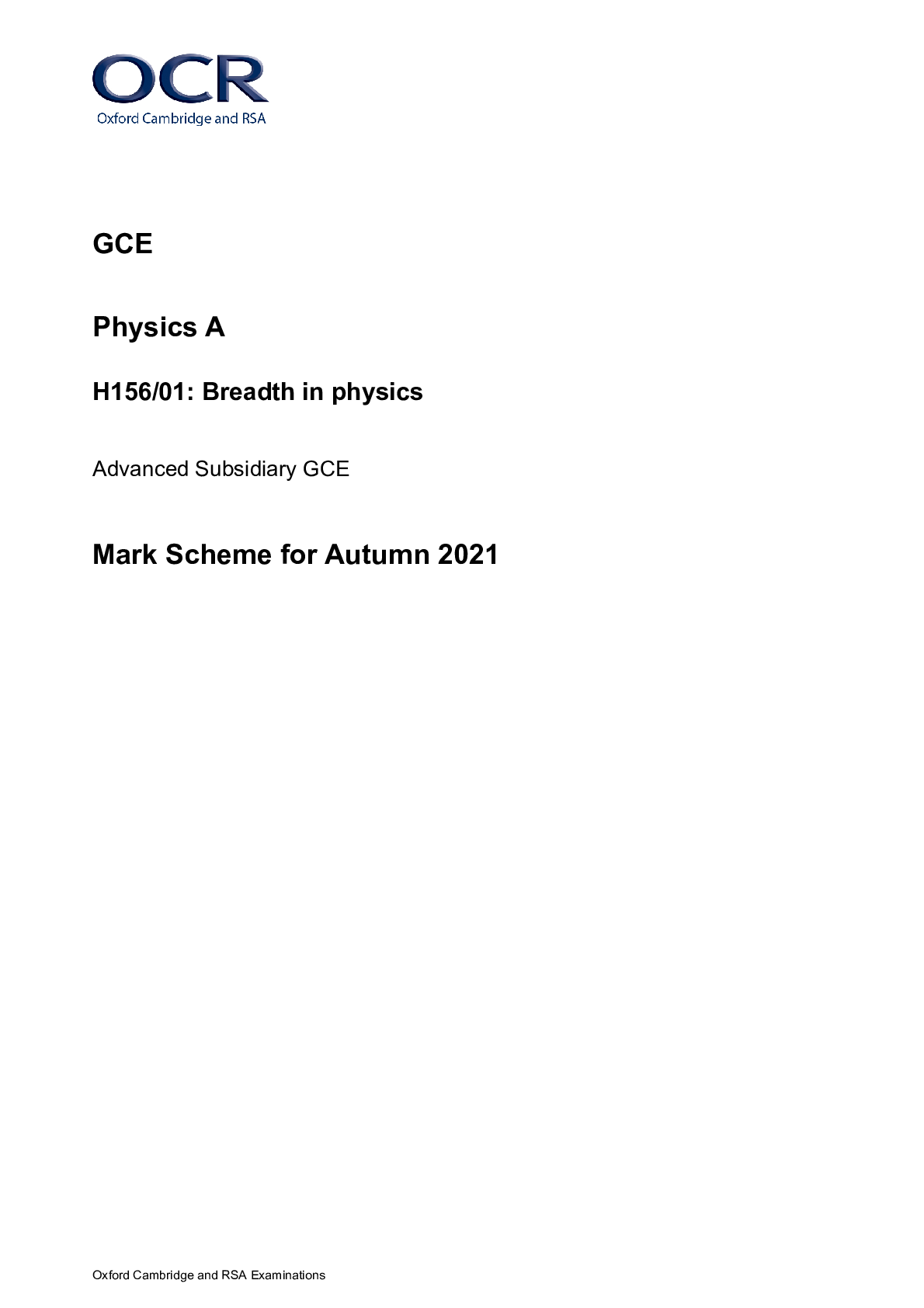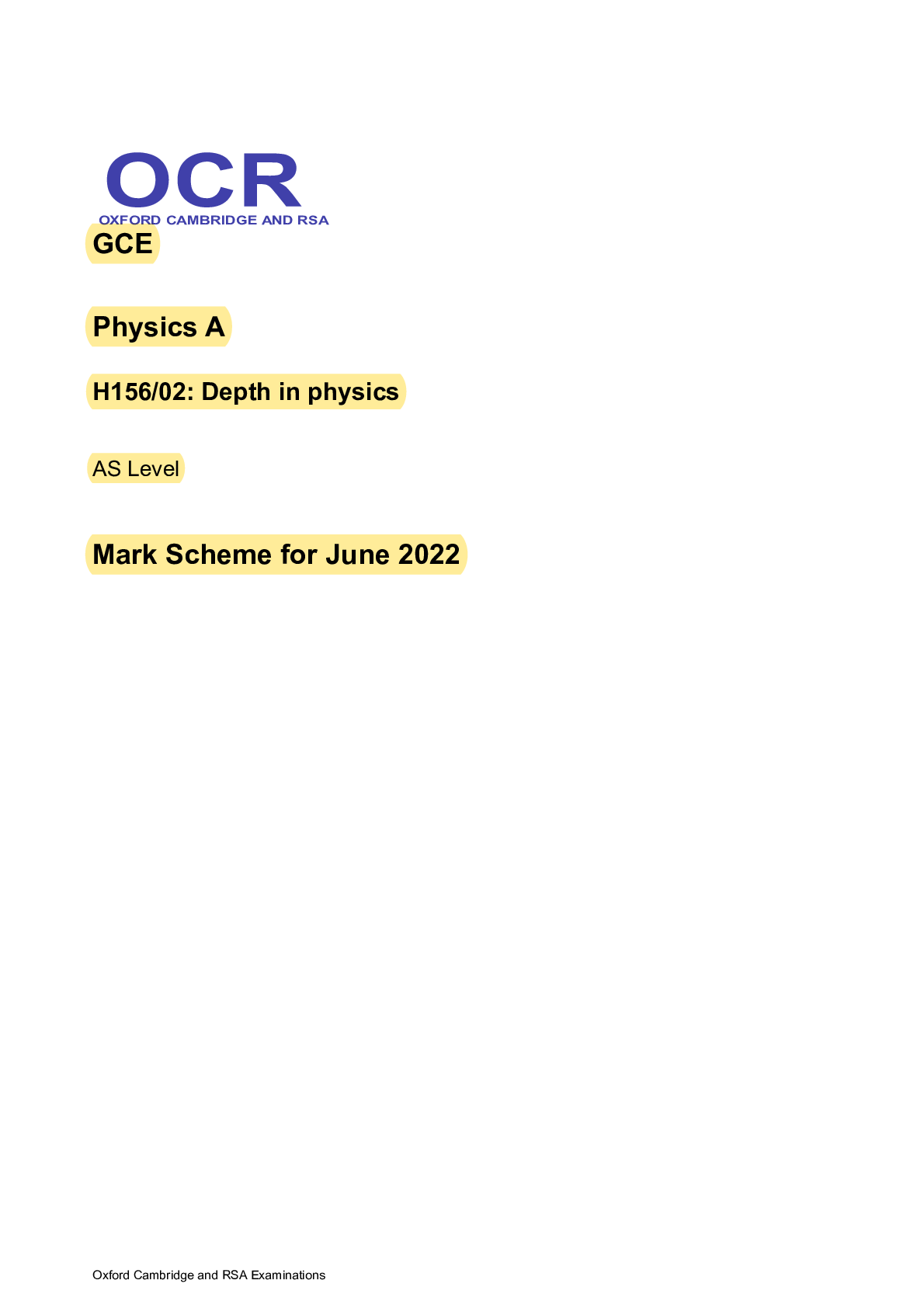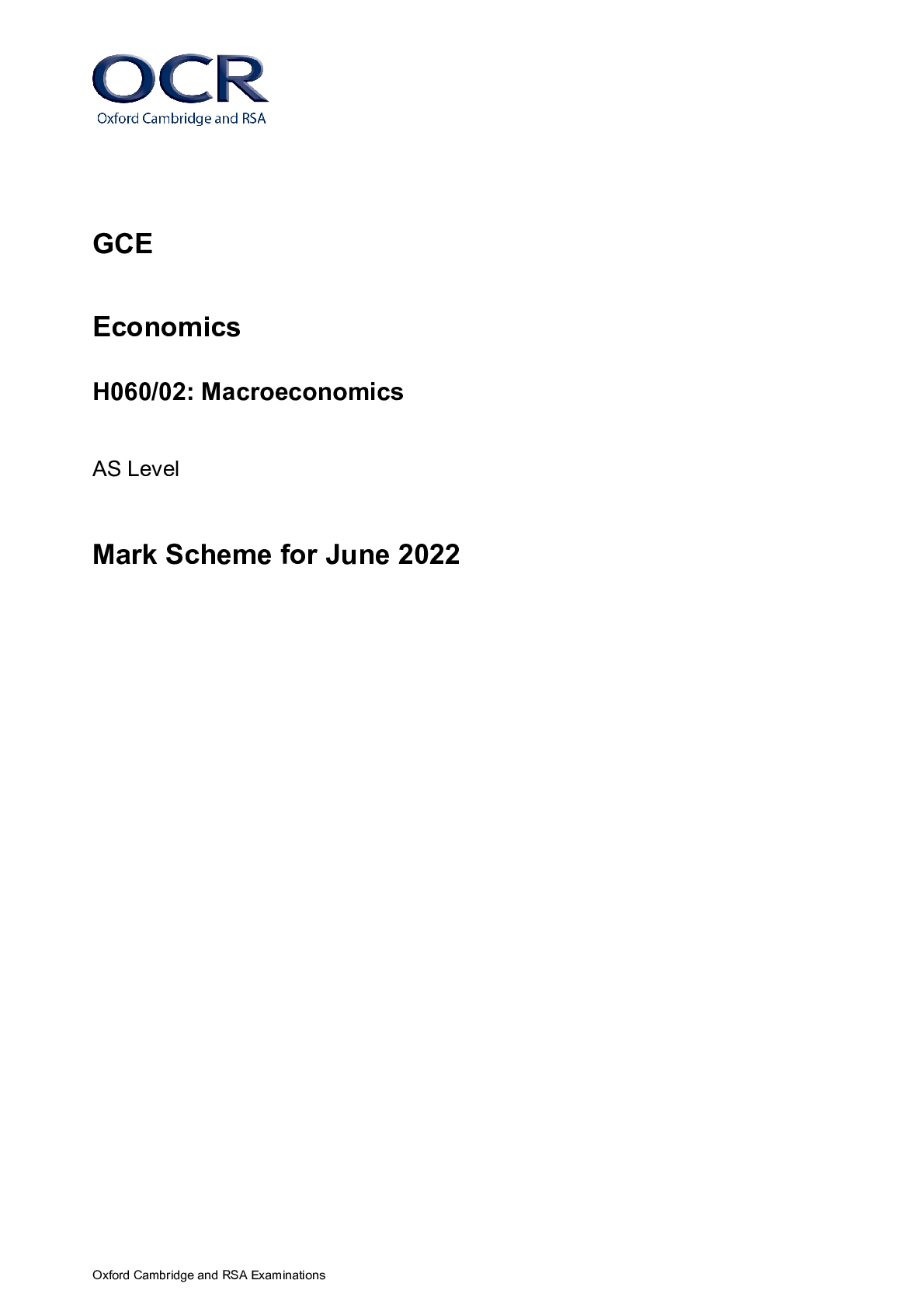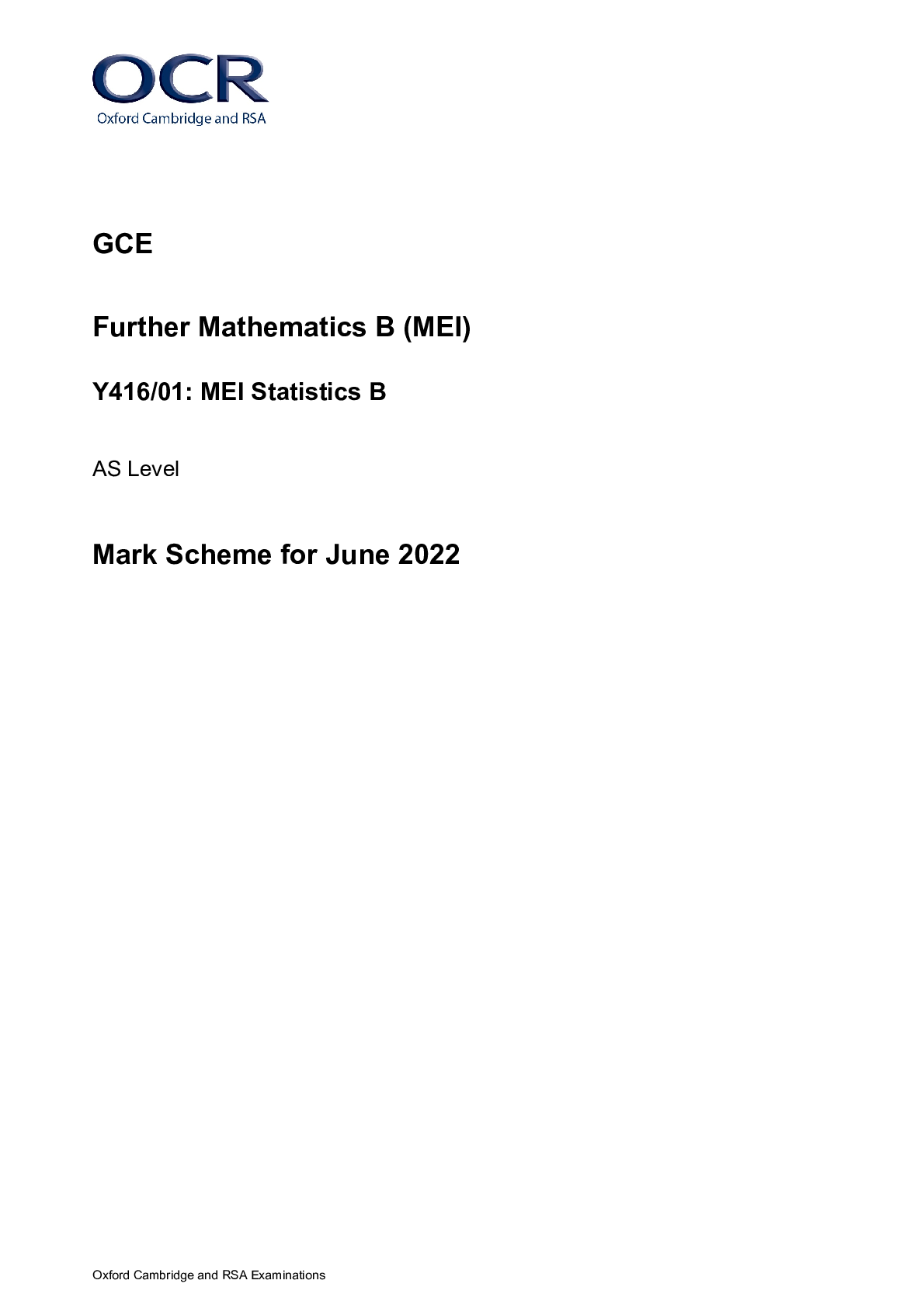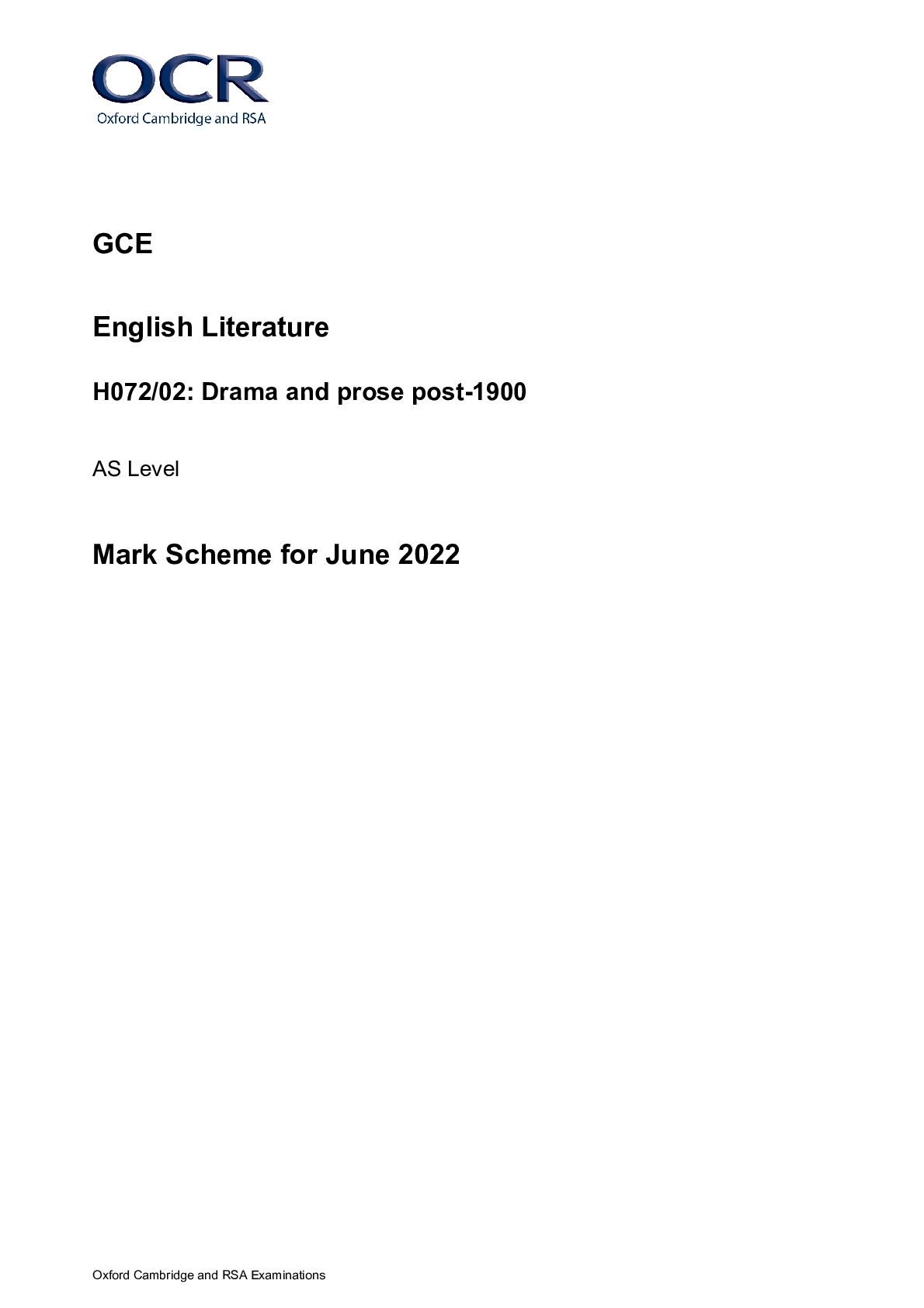Chemistry > AS Level Mark Scheme > A-level CHEMISTRY Paper 3 2 *02* IB/M/Jun22/7405/3 (All)
A-level CHEMISTRY Paper 3 2 *02* IB/M/Jun22/7405/3
Document Content and Description Below
A-level CHEMISTRY Paper 3 2 *02* IB/M/Jun22/7405/3 Do not write outside the There are no questions printed on this page box DO NOT WRITE ON THIS PAGE ANSWER IN THE SPACES PROVIDED 3 *03... * Turn over ► IB/M/Jun22/7405/3 Do not write outside the Section A box Answer all questions in this section. 0 1 A value for enthalpy of solution can be determined in two ways: • from a cycle, using lattice enthalpy and enthalpies of hydration • from the results of a calorimetry experiment. 0 1 . 1 Define the term enthalpy of lattice dissociation. [2 marks] 0 1 . 2 The enthalpy of solution for ammonium nitrate is the enthalpy change for the reaction shown. NH4NO3(s) + aq → NH4 + (aq) + NO3 − (aq) ∆H = +26 kJ mol−1 Table 1 NH4 + (g) NO3 − (g) Enthalpy of hydration hydH/ kJ mol 1 −307 −314 Draw a suitably labelled cycle and use it, with data from Table 1, to calculate the enthalpy of lattice dissociation for ammonium nitrate. [3 marks] Enthalpy of lattice dissociation kJ mol−1 4 *04* IB/M/Jun22/7405/3 Do not write outside the box 0 1 . 3 A student does an experiment to determine a value for the enthalpy of solution for ammonium nitrate. The student uses this method. • Measure 25.0 cm3 of distilled water in a measuring cylinder. • Pour the water into a beaker. • Record the temperature of the water in the beaker. • Add 4.00 g of solid NH4NO3 to the water in the beaker. • Stir the solution and record the lowest temperature reached. Table 2 shows the student’s results. Table 2 Initial temperature / °C 20.2 Lowest temperature / °C 12.2 Calculate the enthalpy of solution, in kJ mol−1, for ammonium nitrate in this experiment. Assume that the specific heat capacity of the solution, c = 4.18 JK−1 g−1 Assume that the density of the solution = 1.00 gcm−3 [3 marks] Enthalpy of solution kJ mol−1 5 *05* Turn over ► IB/M/Jun22/7405/3 Do not write outside the box 0 1 . 4 The uncertainty in each of the temperature readings from the thermometer used in this experiment is ±0.1°C Calculate the percentage uncertainty in the temperature change in this experiment. [1 mark] Percentage uncertainty 0 1 . 5 Suggest a change to the student’s method, using the same apparatus, that would reduce the percentage uncertainty in the temperature change. Give a reason for your answer. [2 marks] Change Reason 0 1 . 6 Another student obtained a value of +15 kJ mol−1 using the same method. Suggest the main reason for the difference between this experimental value for the enthalpy of solution and the correct value of +26 kJ mol−1 [1 mark] Question 1 continues on the next page 6 *06* IB/M/Jun22/7405/3 Do not write outside the box 0 1 . 7 Table 3 shows some entropy data at 298 K Table 3 Entropy S/ JK 1mol 1 NH4NO3(s) 151 NH4 + (aq) 113 NO3 − (aq) 146 Calculate a value for the Gibbs free-energy change (∆G), at 298 K, for the reaction when ammonium nitrate dissolves in water. NH4NO3(s) + aq → NH4 + (aq) + NO3 − (aq) ∆H = +26 kJ mol−1 Use data from Table 3 and the value of ∆H from the equation. Assume for the solvent, water, that the entropy change, ∆S = 0 Explain what the calculated value of ∆G indicates about the feasibility of this reaction at 298 K [4 marks] ∆G kJ mol−1 Explanation 7 *07* Turn over ► IB/M/Jun22/7405/3 Do not write outside the box 0 1 . 8 Ammonium nitrate decomposes as shown. NH4NO3(s) → N2(g) + 1 2 O2(g) + 2H2O(g) ∆H = +123 kJ mol−1 The entropy change (∆S) for this reaction is +144 J K–1 mol−1 Calculate the temperature at which this reaction becomes feasible. [2 marks] Temperature K Turn over for the next question 18 8 *08* IB/M/Jun22/7405/3 Do not write outside the box 0 2 Tschermigite is a hydrated, water-soluble mineral, with relative formula mass of 453.2 The formula of tschermigite can be represented as M.xH2O, where M represents all the ions present. Table 4 shows its composition by mass. Table 4 Element % by mass N 3.09 H 6.18 Al 5.96 S 14.16 O 70.61 In an analysis, it is found that the mineral contains the ions NH4 +, Al 3+ and SO4 2− Calculate the empirical formula of tschermigite and the value of x in M.xH2O Describe the tests, with their results, including ionic equations, that would confirm the identities of the ions present. [6 marks] 9 *09* Turn over ► IB/M/Jun22/7405/3 Do not write outside the box 6 10 *10* IB/M/Jun22/7405/3 Do not write outside the box 0 3 Under suitable conditions, 2-bromobutane reacts with sodium hydroxide to produce a mixture of five products, A, B, C, D and E. Products A, B and C are alkenes. A is a structural isomer of B and C. A does not exhibit stereoisomerism. B and C are a pair of stereoisomers. Products D and E are alcohols. D and E are a pair of enantiomers. 0 3 . 1 Give the names of the two concurrent mechanisms responsible for the formation of the alkenes and the alcohols. [2 marks] Mechanism to form alkenes Mechanism to form alcohols 0 3 . 2 Define the term stereoisomers. [2 marks] 0 3 . 3 Deduce the name of isomer A. Explain why A does not exhibit stereoisomerism. [2 marks] Name Explanation 11 *11* Turn over ► IB/M/Jun22/7405/3 Do not write outside the box 0 3 . 4 Outline the mechanism for the reaction of 2-bromobutane with sodium hydroxide to form alkene A. [3 marks] 0 3 . 5 Deduce the name of isomer B and the name of isomer C. Explain the origin of the stereoisomerism in B and C. [2 marks] Names Explanation 0 3 . 6 Draw 3D representations of enantiomers D and E to show how their structures are related. [2 marks] Question 3 continues on the next page 12 *12* IB/M/Jun22/7405/3 Do not write outside the box 0 3 . 7 A student compares the rates of hydrolysis of 1-chlorobutane, 1-bromobutane and 1-iodobutane. The suggested method is: • add equal volumes of the three halogenoalkanes to separate test tubes • add equal volumes of aqueous silver nitrate to each test tube • record the time taken for a precipitate to appear in each test tube. State and explain the order in which precipitates appear. [2 marks] Order in which precipitates appear Explanation 15 13 *13* Turn over ► IB/M/Jun22/7405/3 Do not write outside the Turn over for the next question box DO NOT WRITE ON THIS PAGE ANSWER IN THE SPACES PROVIDED 14 *14* IB/M/Jun22/7405/3 Do not write outside the box 0 4 Hydrogen peroxide solution decomposes to form water and oxygen. 2H2O2(aq) → 2H2O(l) + O2(g) The reaction is catalysed by manganese(IV) oxide. A student determines the order of this reaction with respect to hydrogen peroxide. The student uses a continuous monitoring method in the experiment. The student places hydrogen peroxide solution in a conical flask with the catalyst and uses a gas syringe to collect the oxygen formed. The student records the volume of oxygen every 10 seconds for 100 seconds. 0 4 . 1 Explain why the reaction is fastest at the start. [2 marks] 15 *15* Turn over ► IB/M/Jun22/7405/3 Do not write outside the box 0 4 . 2 The graph in Figure 1 shows how the concentration of hydrogen peroxide changes with time in this experiment. Figure 1 Tangents to the curve in Figure 1 can be used to determine rates of reaction. Draw a tangent to the curve when the concentration of hydrogen peroxide solution is 0.05 mol dm–3 Use your tangent to calculate the gradient of the curve at this point. [2 marks] Gradient mol dm–3 s–1 Question 4 continues on the next page 16 *16* IB/M/Jun22/7405/3 Do not write outside the box 0 4 . 3 The concentration of hydrogen peroxide solution at time t during the experiment can be calculated using this expression. [ ] [ ] max 22 22 initial max HO HO t t V V V − = [H O2 2 ]t = concentration of hydrogen peroxide solution at time t / mol dm–3 [ 2 2 ]initial H O = concentration of hydrogen peroxide solution at the start / mol dm–3 Vmax = total volume of oxygen gas collected during the whole experiment / cm3 Vt = volume of oxygen gas collected at time t / cm3 In this experiment,Vmax = 100 cm3 Use Figure 1 and the expression to calculate [H O [Show More]
Last updated: 1 year ago
Preview 1 out of 36 pages

Reviews( 0 )
Document information
Connected school, study & course
About the document
Uploaded On
Apr 01, 2023
Number of pages
36
Written in
Additional information
This document has been written for:
Uploaded
Apr 01, 2023
Downloads
0
Views
97

